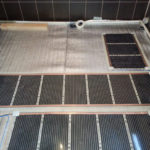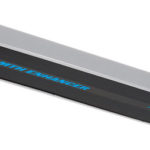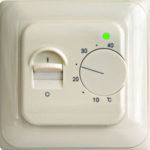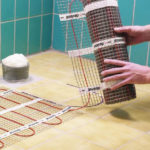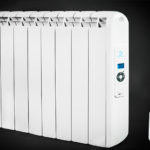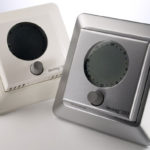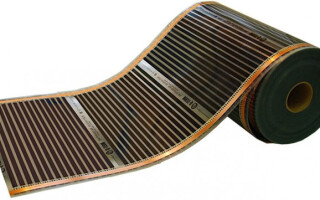The house should always maintain a comfortable air temperature. Often, a warm floor is installed for this purpose. It is not always possible to install electric or water heating. A great alternative is Infrared film heated floors.
Synopsis of
What is an infrared film underfloor heating
Infrared film coating is a rolled material. It is a carbonate paste that is sealed in polyester or polypropylene film. Special conductive bars are installed along the edges. Most often these are strips of silver and copper. It is through them that the electric current is transmitted. After it passes through the carbon, heat is released.
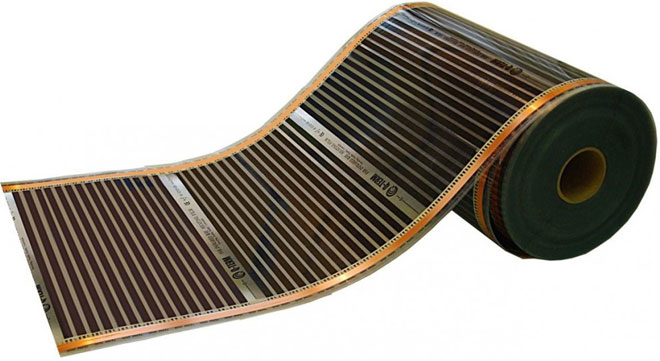
Conductive strips are assembled in sections, between each of them there is a separating strip. It makes it easy to cut the material. The advantage of this system is that if one strip fails, all the others will continue to work.
TIP. Width of one roll of a set of film underfloor heating can vary from 50 cm to 1 m. The thickness of the film is from 0.2 to 2 mm.
Film types of flooring are safe for human health. Infrared underfloor heating does not form electromagnetic waves. Due to the heating of the furniture, the air temperature in the room is lower, but it is quite comfortable. When the objects are heated, there is no air movement, so dust does not rise. This minimizes the risk of developing an allergic reaction. This type of flooring is completely neutral. It does not create any noise, chemical and mechanical effects.
Working Principle
When you turn on the infrared carbon floor, the current passes through the radiocarbon bands. Such a film floor consists of two layers. The first is the film, and in the second are placed heating elements. Most often, this is a nanocarbon paste. It is applied to the film in the form of even or curved strips. The floor with flat strips of heating elements will cost more.
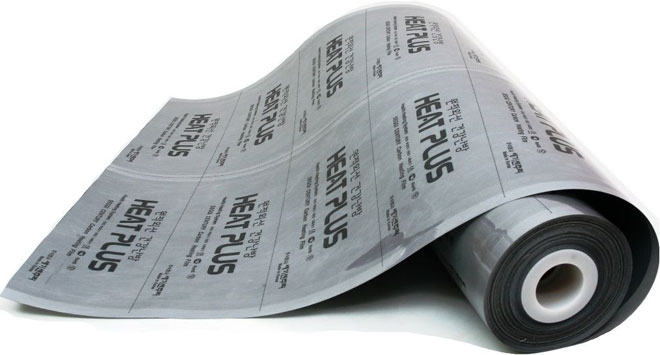
When you turn it on, the coating heats evenly. It is not the air that is heated first, but the objects in the room. The efficiency of this type of heating depends on the correct room layout. If the design of the room is wrong, it is possible to overheat the furniture and walls.
The principle of operation of infrared waves can be compared to the action of an air ionizer, which eliminates unpleasant odors and bacteria.
Types of films and their characteristics
Most infrared films have the same principle of operation. However, different types of film coating are designed for different types of rooms. Depending on the maximum temperature of heating, the following varieties of floor covering are distinguished:
- high-temperature infrared film;
- low-temperature;
- universal.
High-temperature types of infrared floor heating are great for laying under the tiles. The maximum heating temperature is 50°C.
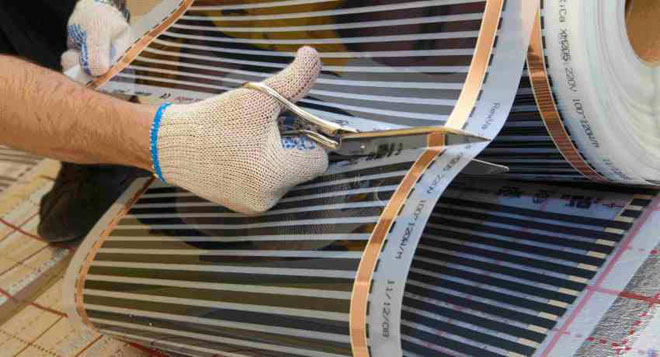
Low temperature infrared flooring can be combined with laminate, linoleum and other heat-sensitive flooring. In this case, the system heats up to 27°C.
There are also a number of universal systems that can be combined with any flooring. They are the most popular, because the buyer does not have to worry about the compatibility of coatings.
The second classification option - by type of heating element. There are several types:
- carbon;
- bimetallic.
When choosing a heated floor, you should also pay attention to the indicator of the specific power. According to this characteristic, there are 3 main types of infrared films:
- weak - 130-160 W/m²;
- Medium - 170 and up to 220 W/m²;
- High - above 220 W/m².
Low wattage film is used in small rooms. It is best combined with lightweight floor coverings. Medium wattages are used in medium sized rooms. An excellent option for tiles and porcelain tiles. High-power foils are installed in large rooms. For example, it can be a sauna or a workshop.
Popular manufacturers
There are many different manufacturers of infrared film underfloor heating. Some of the most popular include:
- Devi;
- Hemstedt;
- Nexans;
- Electrolux;
- Heat Plus;
- Teprolux;
- Thermo;
- RexVa .
Quite popular are the South Korean companies Seggy Century Co, Geosung Ark, Sam Muyung Tech. The peculiarity of these companies is that they give a 50-year warranty on all their products.
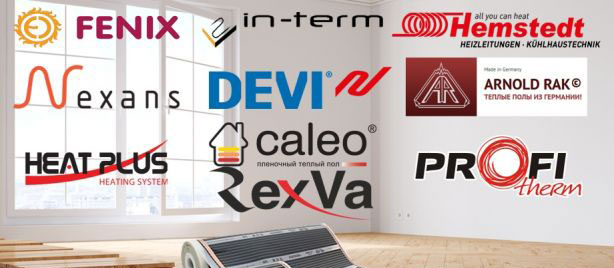
Advantages of infrared flooring
The main advantage of infrared flooring is its long service life. Other advantages include the following features:
- No need to create a concrete screed for installation;
- installation in a few hours;
- compatibility with almost all types of flooring;
- minimum film thickness, which does not affect the estimated thickness of the floor finish;
- low inertia of heating;
- possibility of use in offices, gyms and public places;
- uniform heating of the room;
- Possibility to connect to the system "clever house";
- minimum power consumption;
- no negative impact on human health.
In a room with such heating, the air does not dry out, maintains a comfortable level of humidity. The installation and dismantling process is simple. If necessary, the floor can be dismantled, and the film can be used in another room.
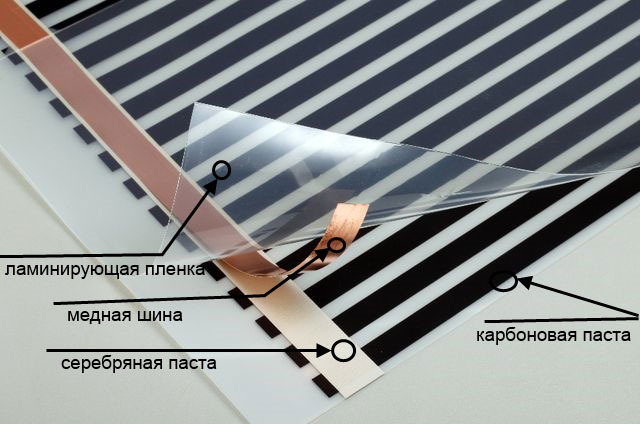
Disadvantages of infrared flooring
Film floors have a large number of hidden contacts. Before installing the flooring, it is necessary to check the functionality of the installed system.
Other disadvantages of infrared flooring include the following features:
- 220V operation;
- it is inexpedient to use such a heating system as the main system;
- places of placement of infrared heaters should not be overlapped by equipment or furniture;
- the need to create an intermediate layer with high strength when installing a soft floor covering.
Operation from the network - a potentially dangerous factor. Despite the fact that there is an earthing, as well as an automatic disconnection system, there is a risk of electrocution.
REFERENCE. Infrared flooring is not as economical as water flooring.
Especially a large gap in the cost of heating is obtained if natural gas is used to operate the water floor. This source of heating is recommended as an additional source.
Before laying a soft floor covering, it is necessary to create an additional solid layer. Plywood, fibreboard and chipboard can be used for this. Creating an additional coating not only improves durability, but also increases financial costs.
All the disadvantages of such a floor can be eliminated with proper planning, competent calculations and installation.
Where to use film systems
Infrared film flooring has a wide range of applications. Such material is used as the main or additional heating:
- living quarters;
- public buildings;
- industrial buildings;
- agricultural buildings.
Often infrared film is used for additional heating of an apartment or house. It can be combined with any flooring. As the main source of heat, such a system is used in rooms where there is no stationary heating or for the period between seasons.
This type of floor heating can be used as a temporary or emergency heating.
BACKGROUND. The film can be installed not only on horizontal, but also on vertical or inclined surfaces.
If necessary, this material can be easily dismantled and moved to another location. If the dismantling area is small, it will take a few minutes.
Infrared film flooring is a great option for heating a public or industrial building. It can be used for additional heating:
- a kindergarten;
- hotel;
- hospital;
- school;
- sports hall.
By connecting a special control panel, you can control the temperature in different rooms simultaneously. Such heating systems are recommended for use in greenhouse facilities and livestock farming. Often, infrared film is used to heat the winter garden or greenhouse. It is also a great option for poultry farms or pig farms.
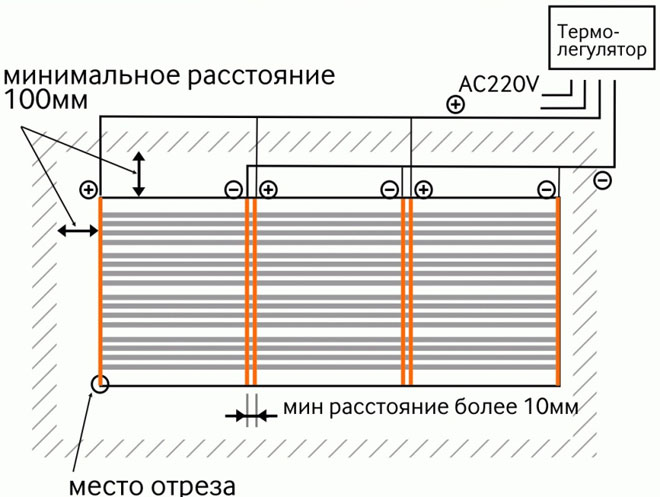
With infrared film flooring you can heat a small room well and maintain an optimal temperature in a large room. It is a good alternative to the water floor or conventional heaters.
Related articles:
